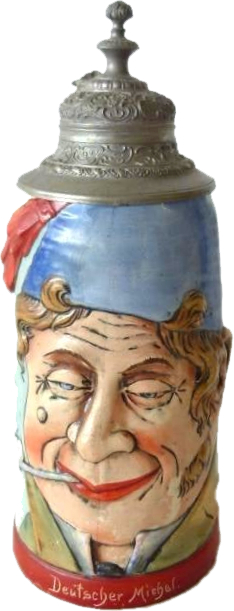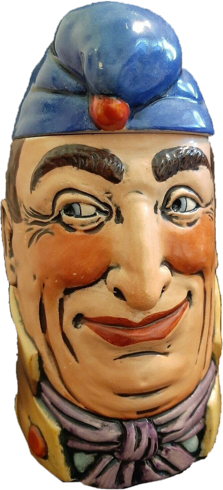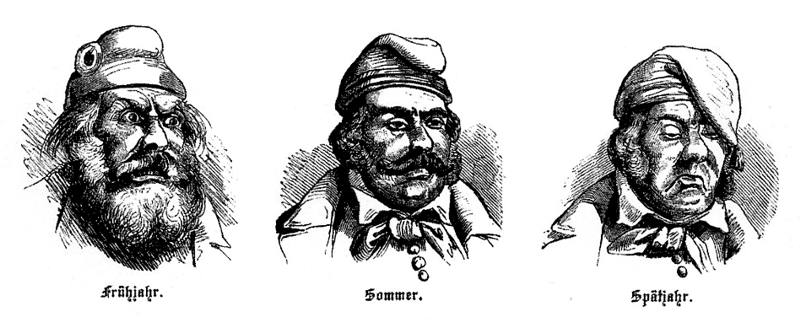
 Stein Collectors International
Stein Collectors International
Featured Stein: February 2021

 Stein Collectors International
Stein Collectors International
Featured Stein:
February 2021
Der
Deutsche Michel (The German Michael) Character Stein
By
Roy De Selms
SCI Master Steinologist, member Carolina Steiners
 This month's Featured
Stein,
seen at left, is Dümler & Breiden #633. A not uncommon stein, for
years it has been referred to as "Man with Pipe" or "Farmer" by
collectors who are not aware of the cultural
history to which it refers.
This month's Featured
Stein,
seen at left, is Dümler & Breiden #633. A not uncommon stein, for
years it has been referred to as "Man with Pipe" or "Farmer" by
collectors who are not aware of the cultural
history to which it refers.
 This
misunderstanding would
probably have continued to go uncorrected
were it not for the inscription on the base rim: "Deutscher Michel"
(German Michael). That inscription is missing from most examples of
this stein. Without the inscription, the only apparent visual clue to
the true
identity of this stein is the blue Phrygian cap which is somewhat
obscured by the pewter lid. In contrast, the distinctive cap on
Rosskopf & Gerz #428 (right) makes it much easier to recognize that
representation of Michel.
This
misunderstanding would
probably have continued to go uncorrected
were it not for the inscription on the base rim: "Deutscher Michel"
(German Michael). That inscription is missing from most examples of
this stein. Without the inscription, the only apparent visual clue to
the true
identity of this stein is the blue Phrygian cap which is somewhat
obscured by the pewter lid. In contrast, the distinctive cap on
Rosskopf & Gerz #428 (right) makes it much easier to recognize that
representation of Michel.
In the years following this case of mistaken identity collectors have
benefited from the discovery and publication of original catalogs. From
them we can sometimes learn the title by which a stein was known at
the time it was offered for sale. In this case, the undated (but early)
Dümler & Breiden
catalog lists this stein as "Trinkseidel,
Flachboden mit großem Kopf (deutscher Michel)" (drinking stein,
flat bottom with large head (German Michel)).
Der deutsche Michel is a fictional figure used to represent the
character of Germany in the same manner that "Uncle Sam" represents
America and "Marianne" personifies the French.
A cartoonish characterization of deutscher
Michel was published in
the March 24 1849 issue of the magazine Eulenspiegel. It shows the mood of
the German people thru the 1848 social revolution and the meetings of
the Parliament of the St. Paul's Church in Frankfurt in June 1848 which
tried to develop the first constitution for a unified Germany. The
movement was immediately squelched by the Prussians who had other
plans. Der Deutsche Michel in
the Frühjahr
(Spring) of 1848 is shown as defiant and looking for social change with
his wild beard and Jakobinermütze
(Liberty Cap; Phrygian Cap). The facial expression became calmer, the
facial hair more conventional, and the hat somewhat deflated during the
Sommer
(summer). Finally, in the Spätjahr
(Autumn) Michel
has acquiesced, his face showing
resignation, and his cap has morphed into a Schlaffmütze
(sleeping cap). The
caption—Michel und seine
Kappe im Jahr 1848 (Michael and his cap in the year 1848)—makes
clear
that the cap is an essential part of any depiction of Michel.

 However,
there's
more
to it than that, and that's shown in this second cartoon which appeared
at the time of World War I. Here Michel is shown sleeping (not
likely while smoking a pipe) and then in a fury when tormented by
Germany's adversaries. The caption
reads "der Michel schläft - doch
wehe, wenn er wacht!" (the Michel
sleeps - but watch out when he
awakens!) and paraphrases the old adage "Let sleeping dogs lie." This
translates to the image of the Michel
being happy to sleep in peace
until being provoked into action. The clever hidden double meaning of
the Nachtmütze/Schlafmütze
(night cap/ sleeping cap) has led to the assumption that all Michels
are wearing night caps. However, it's more likely that this is
also a Phrygian Cap which has been used from the time of the Greeks to
symbolize "Freedom and Liberty" which is Michel's ultimate goal.
However,
there's
more
to it than that, and that's shown in this second cartoon which appeared
at the time of World War I. Here Michel is shown sleeping (not
likely while smoking a pipe) and then in a fury when tormented by
Germany's adversaries. The caption
reads "der Michel schläft - doch
wehe, wenn er wacht!" (the Michel
sleeps - but watch out when he
awakens!) and paraphrases the old adage "Let sleeping dogs lie." This
translates to the image of the Michel
being happy to sleep in peace
until being provoked into action. The clever hidden double meaning of
the Nachtmütze/Schlafmütze
(night cap/ sleeping cap) has led to the assumption that all Michels
are wearing night caps. However, it's more likely that this is
also a Phrygian Cap which has been used from the time of the Greeks to
symbolize "Freedom and Liberty" which is Michel's ultimate goal.